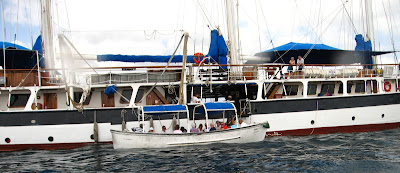I seem to have woken up obscenely early yet again and that so shortly after my "pretend vacation" came to an end on Monday. Fortunately I have a real vacation coming up at the end of the month. My pretend vacation provided the ability to work on whatever I felt like doing, so I worked on a whole whack of bugzillas; check out the
release notes when we publish an EMF build later today with two dozen bugzillas completed. And that doesn't count
prototype work to further ensure that pretty XML doesn't produce ugly models; the idea here is that often XML can contain levels of element nesting that aren't actually useful in the model itself. It's working, but it's still a mess. I wonder when I will find the time? Stop writing huge blogs you say? How rude is that? Be careful, or I'll have to give you one of my patented looks:

Another nice thing I did was to improve the performance of the code that builds state machines for XML Schema content models, i.e., bugzilla
200848. It's sad how slow instanceof and casting really are in Java. I think most folks have little idea how slow these are given how innocent they look and how prevalent they are. It's also sad how inconsistently a VM can behave in terms of JIT optimizing the byte code. It's like a moving target! And with so many JVMs as targets, it's compounded even worse. But enough whining. The reason I bring this bugzilla up in particular is to point out to all you helpful Eclipse people out there that it literally pays to remind your clients that
Eclipse accepts donations. For example, the folks needing the performance boost for the state machine code were ever so grateful and as a result, their CTO, Paul Warren, donated $250. Similarly Christian Meier appreciated all the help I give folks like Philipp Kutter when they have EMF issues that need to be resolved. And of course, going down the list, David Lynch's donation of $500 was a good one! So don't be shy with your reminders!!

Now that I've lulled you with positive thoughts and shown you some mysterious photos, let me slip in here a comment about the "silence of the lambs" since it relates directly to the blog's title topic. For goodness sake, the committer community needs to be more active in expressing its views! We committers and the rest of the community have great influence and don't exploit that nearly enough. Look at all the excellent things
Bjorn is doing in response to the feedback he gets; there's a man who really listens. Please nominate candidates for the
community awards! The
top contributor award is back because of our community's influence. And although I'm ever so grateful to be nominated as
top ambassador, I'd very much prefer not to be the only nominee. I wonder if there is a rule against the same person winning the same award two years in a row?
Chris would be stiff competition. He's always an inspiration to me! So I hope there is a rule, like a presidential term limit, that bans him from running because how does one compete with this?

As Mike blogged yesterday, it's
Eclipse Foundation Election 2008 time. I wonder if anyone will nominate me this year? I sure enjoyed the experience of being a board member. It would be awfully nice if the committers could field more candidates than there are seats. Last year there were five candidates and it turned out that there ended up being five seats. What's an election without losers? It hardly seems like democracy! This year there are only four seats, but you can tell from Mike's hinting that he must have some strategic membership deals he's working on and an increase in membership could result in five committer representative seats yet again. I encourage others to run. If you want to find out more, I'd be happy to chat with would-be candidates individually. Let's make a big splash!

Given that I'd like to be reelected, I was going to look at my position statement from last year's election but it seems to have disappeared. How convenient is that? I can say without fear of contradiction that I did everything I promised and then some! Actually, I'm not sure about that. The board doesn't really work quite the way I expected, though mostly that means it works better than I expected. One of the things I found interesting is that the committer representatives are the folks most likely to come to the meeting with a specific agenda. We have a personal and direct vested interest in helping the foundation to better address committers needs. Nevertheless, effecting change is difficult even with lots of nice people.
One of the issues I tried to help tackle was the issue of how committed are the strategic developers to Eclipse and, mostly importantly, are they in fact living up to the obligations of their signed agreements? So
Nick helped me to create what someone (who shall remain nameless, board confidentiality being what it is) affectionately referred to as the
deadbeat list; and when I say Nick helped I mean, he did all the work and I took all credit. Of course the
link for 2007 is much better populated with data. I thought of it more of a "who's doing what list" but then, as I was told at the board meeting, I have so much charisma; you know, such a statement has so much more weight when the speaker doesn't snicker while saying it and others don't laugh out loud as a result! I was almost completely frosted:

In any case, be very patient when you click on the links. It's best to open them in a new tab or new page and go there later; hopefully this isn't like inviting a denial of service attack! Actually, I think the query results are cached. Please read the disclaimer on the page very carefully as well.
We've asked Mike to vamp up the
directors page with some pictures of faces and biographies so folks feel less like Eclipse is being run as star chamber. Hint hint Mike! See how easy it is to influence others? I was told recently as well that I'm such a subtle person; again, the snickering I could have done without. Here's a frozen twig in lieu of an olive branch for Mike:

Rest assured that the committer representatives are working tirelessly in what we believe are the best interests of the Eclipse community as a whole and for the committers specifically. Note that I qualified it because, as I stated earlier, the community has been stunningly less that vocal about raising issues for us to address, so we are mostly driven by personal passions. For example, we'd really like to see the parallel IP process extended to all projects as soon as possible, but that's taken far longer than we might have hoped. In terms of shorter term results, we've worked closely with Janet and her team to help streamline the IP process with improvements like completion date estimates; Janet's and her team definitely deserve recognition for the improvements they have enacted.
In my opinion, we need to review many of the rules that regulate the board's processes to help modernize them and make them more sensible and relevant for today's Eclipse. I.e., we need to be doing much like what Bjorn is doing with all the rest of the Eclipse processes. For example, the board agenda technically must be be circulated 30 days in advance of the meeting, but for short months, the meetings might be as little as 28 days apart; there's something not quite right about that, clearly! I think the board is often shy to deal with contentious topics; it typically prefers to act only when there is consensus, which is sort of a good thing and sort of incapacitating when there are several dozen board members, i.e., as many as there are geese in this out-of-formation flock:

I think there are many important things the board needs to do in the coming year and I'd certainly like to be a participant in helping the foundation build its momentum. I hope I will have the excellent opportunity and the great honor to serve the community for another year. I'll make sure Eclipse isn't going to the dogs!

Of at least if it does, that the dogs will be cute, loved, and well fed.





 It's time to put an end to this week.
It's time to put an end to this week.
































